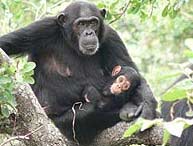For the first time, scientists have traced the origins of the virus most closely related to HIV – the SIV virus – to wild chimpanzees. This discovery has confirmed the hypothesis that wild chimpanzees are the culprits behind the spread of the AIDS epidemic.
 |
| This mother chimpanzee tested positive for SIV. (Image: BBC) |
A report states that a group of chimpanzees has spread HIV. This community resides in Cameroon, said Dr. Beatrice Hahn from the University of Alabama (USA) and her colleagues.
In humans, HIV leads to AIDS, but in chimpanzees, its variant known as SIV (simian immune deficiency virus) does not cause any harm.
So far, SIV has been found in some captive chimpanzees, but Hahn wanted to prove that it could also be found in the wild.
Her team hired professional trackers to locate hidden chimpanzee troops living in southern Cameroon. They collected 599 fecal samples from the subspecies Pan troglodytes troglodytes.
In these fecal samples, Hahn’s team found DNA of the SIV virus and evidence of its presence. They suspected that SIV transmission was quite common among chimpanzee populations.
“In 5 out of the 10 surveyed areas, we found evidence of transmission. A total of 16 infected chimpanzees were recorded, and we were able to decode the viral sequences in all of them“, Hahn said. In some groups, the infection rate reached up to 35% of individuals.
All data was sent for processing at the University of Nottingham. The results showed that some of these SIV gene samples have a very close genetic relationship with HIV strains found in humans.
The research team will continue to investigate why this species does not develop any symptoms, while humans – who share a similar genetic makeup – do.
The Mysterious Transmission Pathway
Hahn’s research suggests that the SIV virus has transmitted from chimpanzees to humans more than once. However, how the infection occurs remains a mystery.
“We know that you cannot get infected just by caring for a chimpanzee or from a toilet seat, just as you cannot contract HIV from a toilet“, Hahn stated.
“Transmission requires contact between bodily fluids and blood. Therefore, it is likely that the virus was transmitted through bites when humans hunt chimpanzees.”
T. An


















































